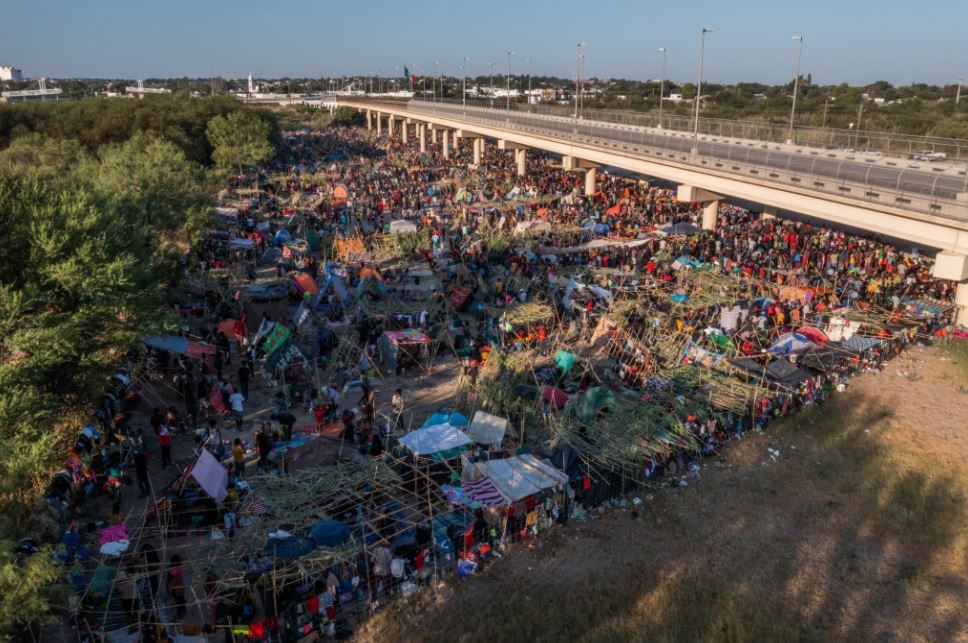
As published October 13, 2022 in The New York Post
As the nation’s “Border Czar,” Vice President Kamala Harris is 20 months into carrying out the White House’s signature “root causes” immigration plan to bring order and security to America’s southern border. The idea behind it was that if America fixes the poverty, physical insecurity, and bad governance that drive emigration from three big sending nations — Honduras, Guatemala and El Salvador — its citizens will rather stay home.
Voila! American border squared away.
So how’s that root causes nation-building project working out so far?

Short answer: About as well as the idea worked for European liberals who first concocted the root-causes doctrine in the early 1980s, resurrected it after the catastrophic mass migration of 2014-2015, and have seen it fail miserably ever since. Border Patrol apprehension numbers, widely regarded as the chief indicator of total crossings, is the ultimate progress report.
In 2020 when Donald Trump was in office, Border Patrol caught 106,762 Hondurans, Guatemalans and Salvadorans. By the end of fiscal 2021, they’d caught 701,049. Border Patrol caught another 505,448 this fiscal year with another month left to count.
Anyone endowed with basic critical thinking and research skills could have predicted this American policy failure, but it was never even lightly challenged. When the Joe Biden campaign first appropriated Europe’s failed liberal social engineering experiment as its chief immigration policy, star-struck American media never bothered to dig into its long, sorry history or demand details for how much it would cost. No one asked when, exactly, the White House would consider Central America “fixed” enough to declare U.S. border security success.
And most importantly, “root causes” ignores a simple equation: People decide to jump the southern border when federal government policies let them illegally cross and stay for long enough to earn back many times the smuggling fee money they borrowed. When they feel the odds of that happening are high, they come. They stay home when they see they’ll be turned away at the American border or be quickly deported to square one, with nothing to show for the smuggling money fortunes they gambled.

The vice president and her acolytes asked Americans to believe that the vast continuing influx that began right after she and Biden took office was all so very “complex.” During an April 2021 state visit to Central America, the border czar laid blame on “extensive storm damage because of extreme climate.” And kept going.
“We’re looking at drought in a region where agriculture is one of the most traditionally important bases for their economy,” she explained. “We’re looking at what’s happening in terms of food scarcity as a result of that.”
To somehow buy away those bad conditions but never explaining how, when or offering accountability benchmarking, the Biden administration pledged a $3 billion down payment to Central America over four years, including $860.6 million in fiscal year 2022 and $986 million in fiscal year 2023. Harris has boasted of coaxing some American companies to invest in Guatemala, Honduras and El Salvador.
But what the root-causes doctrine really does is act as a plausible-sounding cover story for opening the border. At the heart of progressive appreciation for this plausible-sounding strategy was that it would serve not as a complement to American deportation, detention, and deterrence — which cause immigrants to stay home — but as their total replacement. So, while those dollars somehow will rebuild three countries on no particular timeline (a dubious proposition), the Biden administration would leave the border gates open. Americans were told it would all prove out in due time.

But the problem with “due time” is that the European experiment proved that just testing the theory is a generational proposition. To find out, its purveyors would have Americans wait decades for a conclusion at a cost of untold billions of dollars from the national treasury, while foreigners pour across a border left unimpeded. Root-cause conditions certainly exist and encourage poor people everywhere to leave for greener pastures. But European and American government can never hope to improve these conditions quickly enough to explain the monthly, quarterly, and yearly ebbs and flows of mass rushes and retreats.
Policy changes in Washington or the American courts work that mojo, according to my interviews with those making the decisions: immigrants like a Haitian named Alexandre I met one night in the deep southern Mexican city of Tapachula.
In 2016, he and his wife set off through South America on their way to the American border based on presidential candidate Hillary Clinton’s campaign rhetoric about opening the southern border and welcoming in all comers. But Donald Trump won in a surprise upset, and he’d campaigned on building a “big beautiful wall” and deporting all illegal entrants like Alexandre.
So they took shelter and jobs in Chile, watching as Trump policies pushed immigrants back into Mexico and even deported Haitians by air all the way back to Port-au-Prince. The couple had a child, a Chilean citizen. Were Alexandre and his wife willing to gamble the necessary $7,000 in smuggling money they’d saved up working in Chile for his family to probably end up stuck in northern Mexico for the years of Trump, I asked?
Not only no, but hell no, he responded.
“That money, in order to come to the United States . . . I worked hard for that money. I wouldn’t have spent that money when Trump was president.”

But when Biden won office, Alexandre’s whole calculus changed. The couple had been listening intently to every word about the Biden border — and also watching Haitians from Chile being allowed to pour in by the thousands. Only then was he and thousands of other Haitians who’d taken up residencies in Chile willing to risk the smuggling cash. They did what any family would do:
“We talked it over with the family, and we decided to make the trip,” he explained. “Under this president, it seemed like things are different.”
The most cursory glance at Europe’s experience addressing “root causes” from the earliest 1980s pilot programs show the strategy never worked. For example, the European Union-funded policy think tank MIGNEX reviewed some 10 studies spanning more than a decade where development aid was invested to reduce Europe-bound emigration from poor countries.
Of course the border is secure — since Kamala Harris changed the definition of ‘secure’
“In its current form, development aid does not seem to be big enough to create the underlying changes that effect migration decisions,” the MIGNEX report concluded, in part. “In cases where we do see a deterrent effect of aid on migration, a noticeable impact would require an unrealistic increase in aid.”
Writing for the International Institute of Social Studies in 2007, social scientist Hein de Haas concluded that, “Besides the limited scope and credibility of such policies, empirical and theoretical evidence strongly suggests that economic and human development increases people’s capabilities and aspirations and therefore tends to coincide with an increase rather than a decrease in emigration.”
After tilting at the “root causes” windmills, some European nations along the collective’s exterior have turned to what works on migrant decision-making. Since 2015, some 800 miles of border walls have gone up in a half dozen countries, like Austria, Slovenia, Slovakia, the Czech Republic, and Poland. These ended mass migrations through their territories, not some sudden new demand for employment in Afghanistan and Syria.
The European collective uses air repatriation flights now, and other deterrence-based projects that changed immigrant minds, not any sudden outbreak of government integrity in a home country. Policies like walls and air repatriation are what make immigrants want to stay home or go elsewhere.
Other factors gum up the whole idea of the absurd root causes strategem. For instance, root causes proponents of rebuilding Guatemala, Honduras and El Salvador do not take into account that more than 40% of everyone reaching the southern border during this crisis are not from those countries or Mexico but from 100-plus other wrecked countries like Venezuela, Haiti, Cuba, and the Democratic Republic of Congo.
Are Americans expected to pay for eliminating the root causes of those nations too or any new poor nation whose citizens decide to come next? Proponents look away from this question.44
What do you think? Post a comment.
Even if the Democrats expanded the umbrella over every poor nation on Earth, the project does not account for the fact that America is as terrible at nation-building as Europe. Its endeavors fail even after trillions of dollars in expenditures and deployment of American troops. One need only study the examples of Afghanistan and Iraq.
The post-World War II Marshall Plan to rebuild war-wrecked Europe may have been the last success, generations ago. Plans to rebuild Central America do not seem to bake into the cake the terrible failure rate since then. Not to mention the moves needed to truly improve people’s lives — such as regime change in communist dictatorships — would be opposed by the left as foreign meddling by the United States.
As much as the beauty queen contestant in all of us would like to see world hunger alleviated, it is unfortunately here to stay for a long time. Lowering the odds of a smuggling fee payoff is a lever that American leadership can move at will to open and close doors, to stop mass migration immediately.
